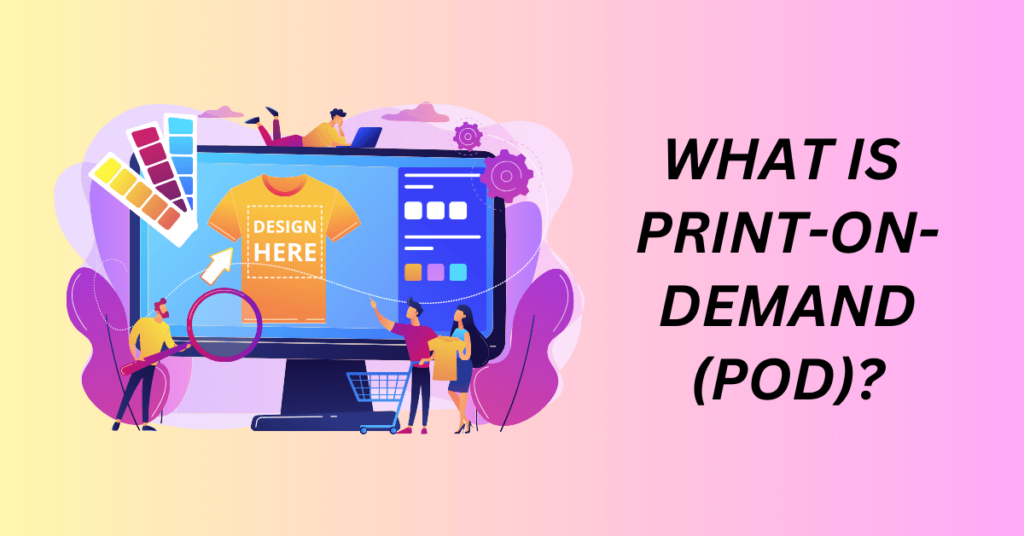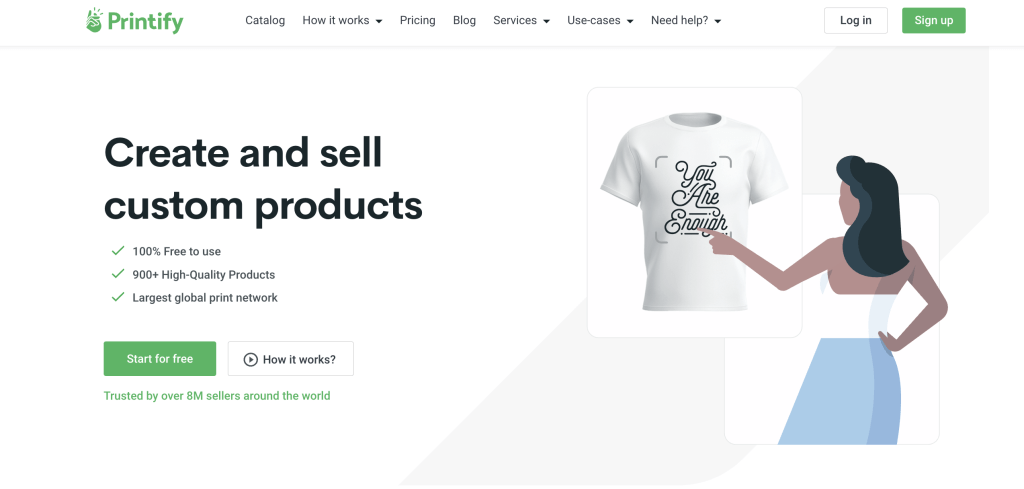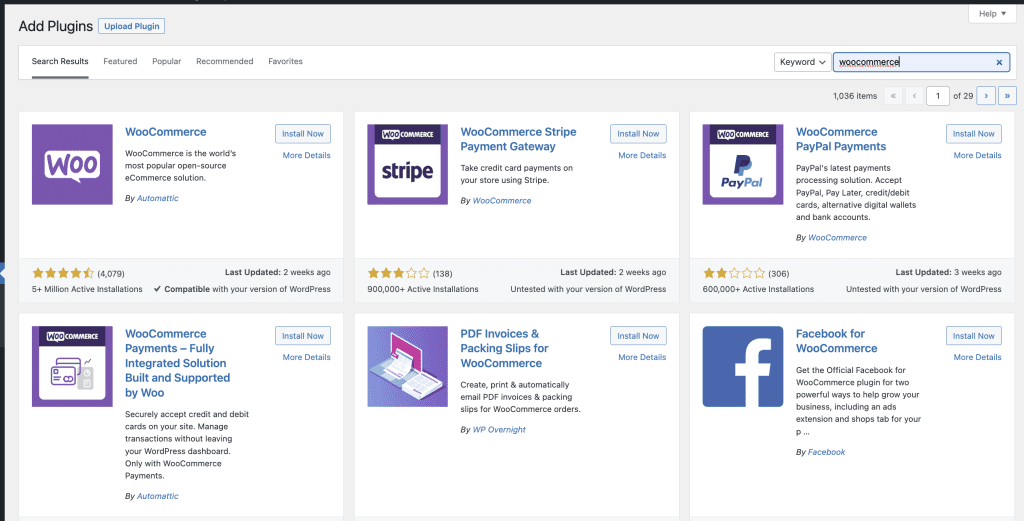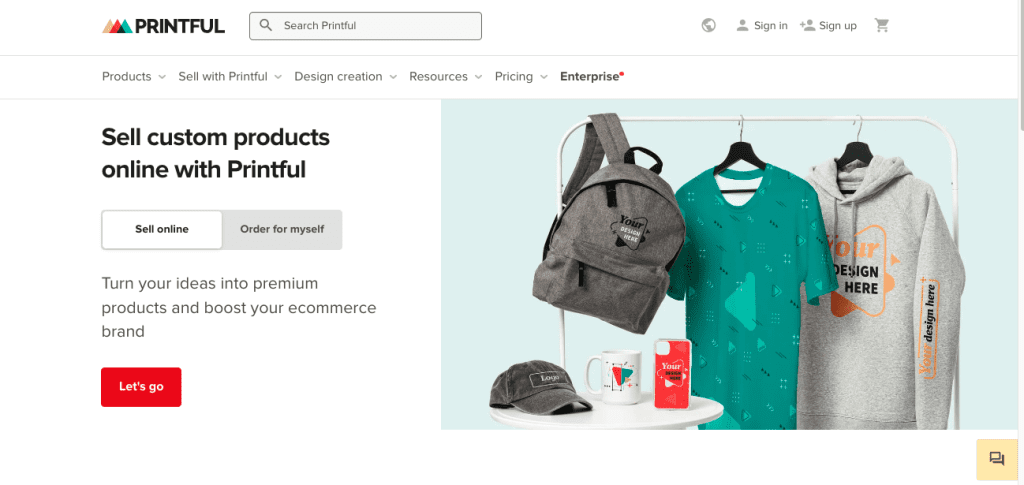Print-on-demand (POD) has revolutionized the way individuals and businesses bring their creative visions to life. Today, we will be sharing how to start and build your successful print-on-demand store from scratch. We’ll guide you through each step, ensuring that your venture not only meets but exceeds the expectations of your target audience.
Whether you’re an artist, a designer, or an aspiring entrepreneur, the power to turn your unique ideas into tangible, customized products is now at your fingertips.
In the digital era, where e-commerce is thriving, harnessing the potential of print-on-demand allows you to venture into the world of retail without the hassles of inventory management and production complexities.
Get an Exclusive Offer for Your WordPress eCommerce Store Hosting
What is Print-on-Demand?

Print on demand (POD) is a modern business model that revolutionizes the traditional approach to printing and distribution. Unlike traditional printing methods, where bulk quantities of a product are produced in advance and stored in inventory, print-on-demand allows for the creation of products as orders are received.
This approach is particularly popular in the context of custom merchandise, such as t-shirts, mugs, posters, and books. The key advantage of print-on-demand is the elimination of upfront costs and excess inventory. This makes it a cost-effective solution for individuals, small businesses, and entrepreneurs.
Print-on-demand operates on a just-in-time production basis, meaning products are manufactured only when there is demand. This not only reduces the financial risks associated with holding excess inventory but also minimizes waste.
Traditional printing methods often require large print runs to be cost-effective, leading to overproduction and the disposal of unsold items. Print-on-demand mitigates these issues by producing items on a per-order basis, contributing to a more sustainable and environmentally friendly business model.
For entrepreneurs and content creators, print on demand provides a low-barrier entry to the market, allowing them to focus on design and marketing without the burdens of inventory management and production logistics. It also enables the sale of niche or personalized products that might not be economically viable with traditional printing methods.
As the e-commerce landscape continues to evolve, print-on-demand remains a versatile and accessible solution for those looking to bring their creative ideas to a global audience.
How Does Print-On-Demand Work?

The process typically begins with a designer or creator uploading their digital designs to a print-on-demand platform. These platforms serve as intermediaries that connect the creator with a network of manufacturers capable of producing a variety of products, such as apparel, accessories, and home goods.
When a customer places an order for a product featuring a specific design, the print-on-demand platform automatically communicates with the chosen manufacturing partner. The manufacturer then prints the design on the selected item, whether it be a t-shirt, mug, poster, or another customizable product. The product is then packaged and shipped directly to the customer.
This on-demand production model allows for a high level of customization, as customers can often choose different product variants, sizes, colours, and styles to suit their preferences.
Benefits of the Print-on-demand Business Model

The print-on-demand (POD) business model offers several compelling benefits that make it an attractive option for entrepreneurs, content creators, and small businesses.
Low Startup Cost
One of the primary advantages is the elimination of upfront costs and the need for inventory investment. Traditional business models often require substantial financial commitments to produce and store large quantities of products.
In contrast, with POD, items are created only when an order is placed, significantly reducing the financial risk associated with excess inventory and allowing entrepreneurs to operate with minimal startup capital.
Flexibility
Another key benefit of the print-on-demand model is the flexibility it provides in terms of product variety and customization. Creators can offer a wide range of products, from apparel and accessories to home goods and promotional items, all featuring their unique designs.
The ability to easily customize products based on customer preferences, such as size, colour, and style, enhances the overall customer experience and caters to diverse market demands. This flexibility allows businesses to test and adapt their offerings quickly, responding to changing trends and customer preferences.
Automation in Logistics & Fulfilment
Print-on-demand also excels in simplifying the logistics and fulfilment aspects of a business. By partnering with POD platforms and manufacturing partners, entrepreneurs can focus on design, marketing, and customer engagement, leaving the complexities of production and shipping to specialized services.
This streamlines the overall operation, freeing up time and resources for business owners to concentrate on creative aspects and growth strategies rather than the intricacies of supply chain management.
Environmental Sustainability
The environmental sustainability of the print-on-demand model is another noteworthy advantage. Traditional manufacturing processes often involve large-scale production runs, contributing to excess waste when products don’t sell. With POD, items are manufactured on a per-order basis, significantly reducing the environmental impact associated with overproduction and unsold inventory.
This aligns with the growing consumer preference for eco-friendly and sustainable business practices, offering a competitive edge to businesses that adopt the print-on-demand model.
Get an Exclusive Offer for Your WordPress eCommerce Store Hosting
Profitable Print-on-demand Products to Sell

The profitability of print-on-demand (POD) products depends on market trends, consumer preferences, and the uniqueness of your designs. Here are several types of POD products that have demonstrated profitability:
Custom Apparel:
T-shirts, hoodies, and sweatshirts with unique and trendy designs are consistently popular. Niche markets, such as specific hobbies or interests, can be particularly lucrative. You should consider targeting specific demographics or subcultures to stand out in a crowded market.
Home Decor:
Items like custom-printed throw pillows, blankets, and wall art allow consumers to personalize their living spaces. Designs ranging from inspirational quotes to abstract art can cater to diverse tastes and preferences.
Accessories:
Custom accessories like phone cases, tote bags, and hats are popular choices. These items often serve as fashion statements, making them ideal for showcasing unique designs or expressing personal style.
Stationery and Office Supplies:
Custom notebooks, planners, and desk accessories are sought after by students, professionals, and anyone who appreciates personalized stationery. Consider creating designs that align with current stationery and productivity trends.
Mugs and Drinkware:
Coffee mugs, travel mugs, and water bottles featuring witty quotes, funny illustrations, or personalized messages continue to be top sellers. Seasonal and thematic designs can also capitalize on holidays and special occasions.
Pet Products:
With the increasing popularity of pet ownership, customized pet products like pet beds, bowls, and clothing have become profitable niches. Designs that celebrate the bond between pets and their owners or showcase pet-related humour can resonate well.
Specialty Prints:
Offering unique prints, such as art prints, posters, and canvas prints, can attract customers looking to decorate their homes with distinctive artwork. Limited edition or exclusive designs can create a sense of urgency and exclusivity.
Tech Accessories:
Custom laptop sleeves, phone skins, and tech gadget accessories provide an opportunity to tap into the tech-savvy market. Designs that merge technology with aesthetics can appeal to a wide audience.
Seasonal and Holiday Products:
Capitalize on holidays and seasonal trends by creating themed products. This includes custom Christmas sweaters, Halloween-themed apparel, and products tailored to specific cultural or regional celebrations.
To maximize profitability, it’s crucial to conduct market research, stay updated on industry trends, and continuously innovate with fresh designs. Additionally, consider the quality of the products, as satisfied customers are more likely to become repeat buyers and advocates for your brand.
Get an Exclusive Offer for Your WordPress eCommerce Store Hosting
How to Create a Print-on-Demand Store
Creating a print-on-demand (POD) store involves several steps, from choosing a niche to setting up your online storefront. Here is a detailed step-by-step guide to help you navigate the process:
1. Create a Print-on-Demand Platform Account
Firstly, you need to find a POD platform. There are different POD platforms out there like Printful, Printify and Teespring.
Once you find the ideal POD company, that suits your business needs, go to their website and sign up for an account. Normally, these platforms will provide free accounts as long as you sign up with them.

Now, click the link and create an account. Remember to read the platform’s terms and conditions thoroughly to understand what you’re signing up for.
If you agree to these terms, fill in the required fields to create your account. Once this is done, you’ll most likely receive a verification request via email. Follow the instructions to verify your account.
And then, you are ready to sell.
2. Choose a Domain Name and Build Your Print-on-Demand Store
Choosing a domain name and building your eCommerce store with WordPress involves strategic decisions to establish a strong online presence. Firstly, you need to select a domain name that aligns with your business identity and is memorable for your target audience.
Take some time to brainstorm and research domain options, considering factors such as niche relevance and brand recognition. Once you’ve settled on a suitable name, register it through a reliable domain registrar like GoDaddy or Namecheap.
With your domain secured, the next step is to set up hosting for your WordPress website. Hosting providers like Bluehost or SiteGround offer plans tailored for WordPress, providing the necessary infrastructure for your eCommerce store.
Get an Exclusive Offer for Your WordPress eCommerce Store Hosting

After setting up hosting, then install WordPress through your hosting provider’s dashboard. WordPress is the foundation of your website and provides a user-friendly interface for content management.

Now that WordPress is installed, integrate WooCommerce, a powerful eCommerce plugin, to enable the creation and management of your online store. WooCommerce offers a setup wizard to guide you through essential configurations, such as defining your store’s location, preferred currency, and setting up shipping and payment methods. This step ensures your store is tailored to your business requirements.
Get an Exclusive Offer for Your WordPress eCommerce Store Hosting
3. Design your Print-on-Demand store
Begin by selecting a responsive WordPress theme that is compatible with eCommerce functionality. Themes like Astra, Storefront, or Divi are popular choices.
A responsive theme ensures that your store looks and functions well on various devices, including desktops, tablets, and smartphones. Look for themes that offer customization options to align with your brand identity.

Once you’ve installed your chosen theme, customize the design elements to create a unique and cohesive look for your eCommerce store. Navigate to the WordPress Customizer, where you can modify colours, fonts, and layout settings. Then, upload your logo, choose a colour scheme that complements your brand, and experiment with different layout options to create a visually appealing storefront.
Next, pay special attention to your product pages, as they are the heart of your eCommerce store. You need to use high-quality product images and provide detailed product descriptions. Also, you need to organize your products into categories and utilize tags for easy navigation.
In addition, consider adding customer reviews and ratings to build trust with potential buyers. WooCommerce allows you to customize product page layouts and styles, enabling you to showcase your products most effectively.
A user-friendly navigation system is crucial for a positive shopping experience. You need to create a clear and intuitive menu structure that makes it easy for visitors to find what they’re looking for. This will also include a search bar to facilitate quick product searches.
Then, implement a straightforward checkout process to minimize cart abandonment. And finally, test your website’s navigation to ensure that users can seamlessly move through your store from product discovery to checkout.
4. Add products to your Print-on-Demand store
After completing designing your online store, you need to integrate your store with the POD platform chosen so that your product can be published to your eCommerce store directly.
Most POD platforms like Printify and Printful offer easy integration to major eCommerce platforms or marketplace. All you need to do is to follow the guide and complete the integration.
5. Set up payment options
Most POD companies will handle the shipping and fulfilment. And for your side, you will then need to handle the payment options for your customers.

To make it easy for your customers to make payments and buy from you, choose secure payment gateways that support different currencies. Popular options include PayPal, Stripe and credit card processors.
Once you’ve chosen your payment gateways, integrate them into your eCommerce platform so that your customers can select their preferred payment method during checkout.
6. Promote your Print-on-Demand store
Effectively promoting your print-on-demand store is crucial for driving traffic, increasing sales, and building a loyal customer base. Here are three strategies to help you promote your print-on-demand store:
Social Media Marketing:
Firstly, you can leverage the power of social media to showcase your custom-designed products. You can do this by creating engaging and visually appealing content that highlights your unique offerings. Utilize platforms such as Instagram, Facebook, Pinterest, and Twitter to share product images, behind-the-scenes content, and customer testimonials. Then, you should consider running targeted social media ads to reach a wider audience and drive traffic to your online store. Also, engage with your followers, respond to comments, and use relevant hashtags to increase the discoverability of your products.
Influencer Partnerships:
Collaborate with influencers who align with your brand and target audience. Identify influencers in your niche or industry who have a significant following and engage with their audience authentically. Reach out to potential influencers and propose partnerships, whether it be through sponsored posts, product reviews, or giveaways.
In short, influencers can help amplify your brand, introduce your products to a new audience, and provide valuable social proof that encourages potential customers to make a purchase.
Content Marketing and SEO:
Develop a content marketing strategy to improve your store’s search engine visibility and attract organic traffic. Create blog posts, articles, or videos that revolve around topics related to your niche or products. Optimize your content for relevant keywords to improve your search engine rankings.
Then, share your content on social media, and consider guest posting on relevant blogs or websites to reach a wider audience. Regularly update your blog with informative and engaging content to establish your store as an authority in your niche, driving both traffic and potential customers.
Incorporate a mix of these promotional strategies, and tailor your approach based on your target audience and the nature of your print-on-demand products. Consistency is key, so regularly assess the performance of your promotional efforts and adjust your strategy accordingly. By combining social media marketing, influencer partnerships, and content marketing, you can effectively promote your print-on-demand store and increase its visibility in a competitive online landscape.
Factors to Consider when Choosing a Print-on-Demand Platform
Choosing the right print-on-demand (POD) platform is crucial for individuals and businesses looking to sell custom-designed products without the hassle of inventory management and order fulfilment. Several factors should be carefully considered to ensure that the chosen POD platform aligns with your goals and meets your specific needs.
Product Variety and Quality
First and foremost, product variety and quality are paramount. You need to evaluate the range of products a POD platform offers, such as T-shirts, mugs, phone cases, and more.
Additionally, assess the quality of the final printed products by ordering samples or researching reviews. The reputation of the POD platform in terms of print quality and product durability is essential to maintain customer satisfaction and loyalty.
Ease of Use
Another critical factor is the ease of use of the platform. A user-friendly interface and straightforward design tools can significantly impact your experience as a seller.
Look for platforms that offer intuitive design tools, easy product creation, and a smooth ordering process. This ensures that you can quickly bring your designs to market without unnecessary complications.
Shipping and Fulfilment
Shipping and fulfilment services play a pivotal role in the success of a POD venture. Consider the POD platform’s shipping options, delivery times, and shipping costs. Timely and reliable delivery is crucial for customer satisfaction, and transparent shipping policies can help you set accurate expectations for your customers.
Some POD platforms also provide tracking information, allowing you and your customers to monitor the status of orders in real-time.
Product and Shipping Cost
Cost is another vital aspect to consider. Different POD platforms have varied pricing structures, including base costs for products, printing fees, and shipping charges.
Take into account your budget, the expected profit margins, and any additional fees associated with using the platform. Some platforms may offer bulk discounts or tiered pricing, providing cost advantages as your sales volume increases.
Integration & Customization
Consider the platform’s integrations and customization options. You want to choose a platform that can integrate with e-commerce platforms like Shopify, Etsy, or WooCommerce. This can simplify the selling process and expand your reach.
Additionally, assess the level of customization the platform allows for your storefront. Having the ability to brand your store and create a unique shopping experience can contribute to the success of your POD business.
Customer Support and Community
Lastly, evaluate the POD platform’s customer support and community. A responsive customer support team can assist you in resolving any issues or concerns promptly. Explore community forums, social media groups, or reviews to gauge the experiences of other sellers on the platform.
A supportive and active community can provide valuable insights, tips, and troubleshooting assistance, fostering a collaborative environment.
Choosing a print-on-demand platform requires a careful analysis of various factors, including product variety and quality, ease of use, shipping and fulfilment services, cost considerations, integrations, and customer support. By thoroughly evaluating these aspects, you can make an informed decision that aligns with your business goals and ensures a positive experience for both you and your customers.
Popular Print-on-Demand Platforms
Printify and Printful are both popular print-on-demand platforms that allow individuals and businesses to create and sell custom-designed products without the need for inventory or upfront costs. Both platforms are one of the top in the print-on-demand market.
Printify:

Printify is a print-on-demand dropshipping platform that connects merchants with a network of print providers. It enables users to create and sell custom products, such as apparel, home goods, and accessories, by integrating with various e-commerce platforms. Printify offers a Free plan with limited features. And if you subscribe to premium plans at $24.99 per month, you will get 20% off your product price and up to 10 stores per account.
Features:
Product Catalog: Printify offers a wide range of customizable products, including T-shirts, hoodies, phone cases, and more.
Integration: It integrates with popular e-commerce platforms like Shopify, WooCommerce, Etsy, and others, making it easy for users to set up their online stores.
Supplier Network: Printify works with a network of printing partners globally, allowing users to choose from different providers based on factors like location, pricing, and product offerings.
Mockup Generator: Users can create product mockups to showcase their designs before adding them to their online stores.
Create Your Free Printify Account
Printful:

Printful is a print-on-demand and drop shipping platform that allows users to design and sell custom products. It integrates with various e-commerce platforms, simplifying the process of creating and selling personalized merchandise. Printful is a free-to-use platform. You only pay after a customer orders your products.
Features:
Product Range: Printful offers a diverse range of customizable products, including apparel, accessories, home decor, and promotional items.
Integration: It seamlessly integrates with popular e-commerce platforms such as Shopify, WooCommerce, and others, enabling users to sync their products and orders effortlessly.
Warehousing (optional): Printful provides warehousing services, allowing users to store inventory with Printful and fulfil orders automatically.
Print Quality: Printful is known for its high print quality, and it offers a range of printing techniques, including direct-to-garment (DTG) printing and embroidery.
Create Your Free Printful Account
Final thoughts: How To Create a Profitable Print-on-Demand Store
Print-on-demand is the perfect business model for new entrepreneurs who are looking for a low-risk and investment business. This business model has enabled anyone to set up their business very easily and not be required to hold any inventory.
With this, you can start and run your business in no time. Besides, you can test different products fast by just completing the design and start selling. When you get the winning design, you can order in bulk to lower your product cost and shorten your shipping time.
Building your eCommerce store is one of the most important steps in starting a successful POD business. With your platform, you can customize your customer journey and optimize the checkout process. This will increase your conversion rate and revenue.
If you’re new to web design, you can get help from a reliable web hosting company like Bluehost. It’s one of the best web hosting services out there for you to start your WordPress website.
Explore different hosting plans available with the exclusive discount. We will support you with any web development queries too.
Get an Exclusive Offer for Your WordPress eCommerce Store Hosting





